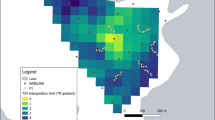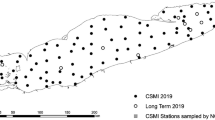Abstract
Growing salmon in sea cages results in the deposition of uneaten feed and wastes which can smother organisms, increase biological oxygen demand, and alter seafloor communities. At some sites with mainly hard-bottom substrates, opportunistic annelids and mat-forming bacteria are used as visual indicators of aquaculture waste and are monitored via drop camera imaging. Additionally, high organic matter sedimentation rates can result in the proliferation of microbes that release gas; this offgassing could also serve as a useful visual enrichment indicator. Little is known of how the distribution of opportunistic annelids, microbial mats, and offgassing might change over time and space, although coverage has important repercussions in some regulatory schemes. Here, we explore spatiotemporal distributions of offgassing, bacterial mats, annelids, and epibenthic taxon richness based on existing video-monitoring data collected along transects at four Newfoundland aquaculture sites in 2011–2012. A high degree of spatial and temporal patchiness was observed at both fallow and production sites, and combinations of time, transect, and distance to cage explained the distribution of bacterial mats, annelids, and taxon richness. Expected successional patterns resulting from organic enrichment or remediation were evident in some patches. Offgassing was observed only at fallow sites and may signal a distinct and persistent phase in organic matter degradation. Results highlight the spatial heterogeneity of benthic organic enrichment indicators across transects at Newfoundland aquaculture sites, with indicators appearing to form a mosaic of patches undergoing different stages of enrichment or recovery.





Similar content being viewed by others
References
Asche F, Roll KH, Tveterås S (2008) Future trends in aquaculture: productivity growth and increased production. In: Holmer M, Black K, Duarte CM, Marbà N, Karakassis I (eds) Aquaculture in the Ecosystem. Springer, Dordrecht
Broch OJ, Daae RL, Ellingsen IH et al (2017) Spatiotemporal dispersal and deposition of fish farm wastes: a model study from central Norway. Front Mar Sci 4:199
Buschmann AH, Riquelme VA, Hernández-González MC et al (2006) A review of the impacts of salmonid farming on marine coastal ecosystems in the southeast Pacific. ICES J Mar Sci 63:1338–1345
Carroll ML, Cochrane S, Fieler R et al (2003) Organic enrichment of sediments from salmon farming in Norway: environmental factors, management practices, and monitoring techniques. Aquaculture 226:165–180
Chris J. Cromey, Thom D. Nickell, Kenneth D. Black, Paul G. Provost, Colin R. Griffiths, (2002) Validation of a fish farm waste resuspension model by use of a particulate tracer discharged from a point source in a coastal environment. Estuaries 25 (5):916-929
Cole DW, Cole R, Gaydos SJ et al (2009) Aquaculture: Environmental, toxicological, and health issues. Int J Hyg Environ Health 212:369–377
Fisheries and Oceans Canada (2016) Statistics on aquaculture production quantities and values, 2000-2014. www.dfo-mpo.gc.ca/stats/aqua/aqua-prod-eng.htm Cited 27 July 2018
Fisheries and Oceans Canada (2018). Aquaculture Activities Regulation. http://www.dfo-mpo.gc.ca/aquaculture/management-gestion/aar-raa-eng.htm Cited 16 August 2018
Hamoutene D (2014) Sediment sulphides and redox potential associated with spatial coverage of Beggiatoa spp. at finfish aquaculture sites in Newfoundland, Canada. ICES J Mar Sci 71:1153–1157
Hamoutene D, Mabrouk G, Sheppard L et al (2013) Validating the use of Beggiatoa sp. and opportunistic polychaete worm complex (OPC) as indicators of benthic habitat condition at finfish aquaculture sites in Newfoundland. Can Tech Rep Fish Aquat Sci 3028: v + 19 p
Hamoutene D, Sheppard L, Mersereau J et al (2014) Applicability of the use of visual indicators [presence of Beggiatoa and/or Opportunistic Polychaete Complexes (OPC)] to identify benthic changes due to aquaculture on various substrates. DFO CSAS Res Doc 63
Hamoutene D, Salvo F, Bungay T et al (2015) Assessment of finfish aquaculture effect on Newfoundland epibenthic communities through video monitoring. N Am J Aquac 77:117–127
Hamoutene D, Salvo F, Donnet S et al (2016) The usage of visual indicators in regulatory monitoring at hard-bottom finfish aquaculture sites in Newfoundland (Canada). Mar Pollut Bull 108:232–241
Hargrave BT (2010) Empirical relationships describing benthic impacts of salmon aquaculture. Aquacult Env Interac 1:33–46
Holmer M, Argyrou M, Dalsgaard T et al (2008) Effects of fish farm waste on Posidonia oceanica meadows: synthesis and provision of monitoring and management tools. Mar Pollut Bull 56:1618–1629
Keeley NB, Macleod CK, Hopkins GA et al (2014) Spatial and temporal dynamics in macrobenthos during recovery from salmon farm induced organic enrichment: When is recovery complete? Mar Pollut Bull 80:250–262
Keeley NB, Forrest BM, Macleod CK (2015) Benthic recovery and re-impact responses from salmon farm enrichment: Implications for farm management. Aquaculture 435:412–423
Lin DT, Bailey-Brock JH (2008) Partial recovery of infaunal communities during a fallow period at an open-ocean aquaculture. Mar Ecol Prog Ser 371:65–72
Mabrouk G, Bungay T, Drover D et al (2014) Use of remote video survey methodology in monitoring benthic impacts from finfish aquaculture on the south coast of Newfoundland (Canada). DFO CSAS Res Doc 39
Macleod CK, Moltschaniwskyj NA, Crawford CM (2006) Evaluation of short-term fallowing as a strategy for the management of recurring organic enrichment under salmon cages. Mar Pollut Bull 52:1458–1466
Macleod CK, Moltschaniwskyj NA, Crawford CM et al (2007) Biological recovery from organic enrichment: some systems cope better than others. Mar Ecol Prog Ser 342:41–53
Naylor RL, Goldburg RJ, Primavera JH et al (2000) Effect of aquaculture on world fish supplies. Nature 405:1017–1024
Osborne T (2017) The Economic Review 2017. http://www.economics.gov.nl.ca/pdf2017/theeconomicreview2017.pdf
Pearson TH, Rosenberg R (1978) Macrobenthic succession in relation to organic enrichment and pollution of the marine environment. Oceanogr Mar Biol 16:229–311
Salvo F, Mersereau J, Hamoutene D et al (2017a) Spatial and temporal changes in epibenthic communities at deep, hard bottom aquaculture sites in Newfoundland. Ecol Indic 76:207–218
Salvo F, Dufour SC, Hamoutene D (2017b) Temperature thresholds of opportunistic annelids used as benthic indicators of aquaculture impact in Newfoundland (Canada). Ecol Indic 79:103–105
Satterthwaite F (1946) An Approximate Distribution of Estimates of Variance Components. Biom Bull 2:110–114
Taranger GL, Karlsen Ø, Bannister RJ et al (2014) Risk assessment of the environmental impact of Norwegian Atlantic salmon farming. ICES J Mar Sci 72:997–1021
Verhoeven JT, Salvo F, Hamoutene D et al (2016) Bacterial community composition of flocculent matter under a salmonid aquaculture site in Newfoundland, Canada. Aquacult Env Interac 8:637–646
Villnäs A, Perus J, Bonsdorff E (2011) Structural and functional shifts in zoobenthos induced by organic enrichment—implications for community recovery potential. J Sea Res 65:8–18
Werkman M, Green DM, Murray AG et al (2011) The effectiveness of fallowing strategies in disease control in salmon aquaculture assessed with an SIS model. Prev Vet Med 98:64–73
Wildish DJ, Pohle GW (2005) Benthic macrofaunal changes resulting from finfish mariculture. In: Hargrave B (ed) Environmental Effects of Marine Finfish Aquaculture. Springer, Berlin
Yang CS, Kao SP, Lee FB et al (2004) Twelve different interpolation methods: A case study of Surfer 8.0. In: Proceedings of the XXth ISPRS Congress, Int Arch Photogramm 35:778–785
Zhulay I, Reiss K, Reiss H (2015) Effects of aquaculture fallowing on the recovery of macrofauna communities. Mar Pollut Bull 97:381–390
Acknowledgments
We acknowledge the assistance of our industry partners in facilitating this project.
Funding
Fieldwork was funded through the Aquaculture Collaborative Research and Development Program (ACRDP) and the Program for Aquaculture Regulatory Research (PARR).
Author information
Authors and Affiliations
Corresponding author
Additional information
Publisher’s note
Springer Nature remains neutral with regard to jurisdictional claims in published maps and institutional affiliations.
Electronic supplementary material
ESM 1
(PDF 107 kb)
Rights and permissions
About this article
Cite this article
Armstrong, E.G., Mersereau, J., Salvo, F. et al. Temporal change in the spatial distribution of visual organic enrichment indicators at aquaculture sites in Newfoundland, Canada. Aquacult Int 28, 569–586 (2020). https://doi.org/10.1007/s10499-019-00478-z
Received:
Accepted:
Published:
Issue Date:
DOI: https://doi.org/10.1007/s10499-019-00478-z




